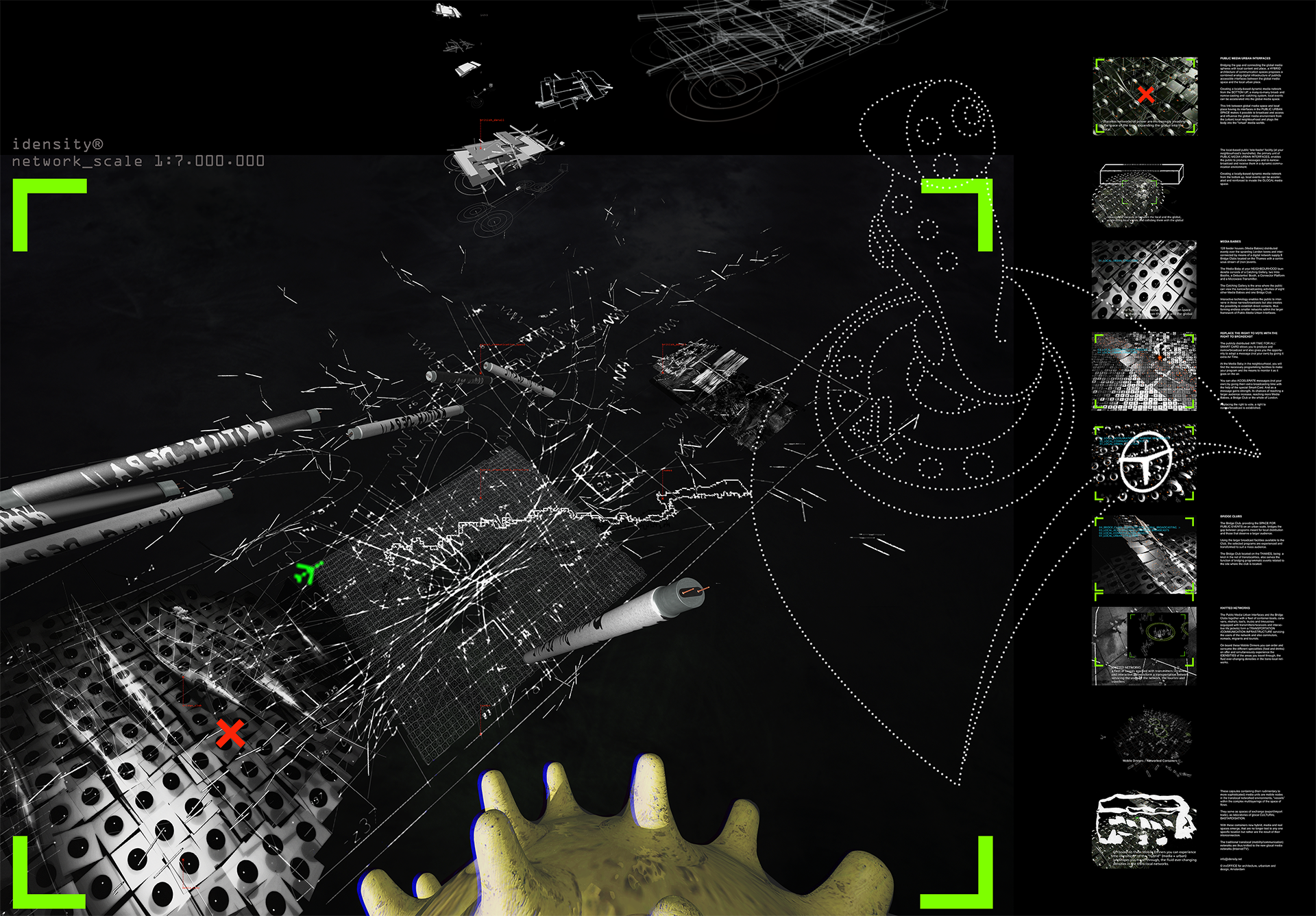Concept Hybrid Space © Hybrid Space Lab, Berlin, 1988~2024
Networked
Space
Hybrid Space considers the physical environment in the context of and in relation to the networks that it belongs to and interacts with.
Hybrid Space Lab pioneered the development of the Hybrid Space concept, by coining the qualitative new space that emerges from the fusion and interference of physical spaces with digital networks as “Hybrid Space”. “Hybrid Space” as new field is in juxtaposition with Manuel Castells’ approach with its binary division between “Space of Flows” and “Space of Places” (Castells, M., 1996. The Rise of the Network Society. Massachusetts: Blackwell Publishers Inc..)
The starting point and core of the Hybrid Space concept consists in acknowledging the fusion of digital and physical environments, the embedment and integration of media networks in urban, architectural, social, biological and cultural spaces.
Our environments are today being rapidly transformed by the Digital, ubiquitously pervading and transforming the Physical as well as the social, cultural and economic organizations of our societies. Hybrid Spaces are today everywhere in our daily lives. From the communication space of mobile telephony, which creates illusionary privacy islands within public spaces, to monitored environments, where cameras keep watch. The workplace becomes an integral part of the home, the office becomes a space for encounters with a meeting lounge atmosphere, the connected car becomes a mobile extension of our networked existence – to name a few examples.
Hybrid Space focuses therefore on the hybrid fields emerging from the combination and fusion of environments, objects, and services within their networked systems of production, distribution, use, and recycling in the information/communication age.
Thus, by addressing environments in their multiplicity of dimensions, the concept of Hybrid Space expanded, considering in an integrated way – next to physical space and media networks – built space and natural environments as well.
In the times of the Aristotelian categories, the notion of the “hybrid”, the crossbreed had a negative connotation. Today the notion of the “hybrid” is everywhere, with hybridization becoming an increasingly important phenomenon – also with cultural hybridizations between and within fields, for example the cultural sphere.
The ‘hybrid’ turned into a strategy, today’s challenges needing to be addressed from multiple perspectives. Issues such as climate and sustainability, heritage and museums, urban development and mobility, health, tourism, retail, and other are increasingly being interwoven with each other and new hybrid fields emerge. Combining knowledge from different fields enables to address the complexity and transferring concepts and ideas from one field to another, helps re-frame challenges, opening paths for innovative approaches.
Hybrid Space Lab therefore develops ‘hybrid strategies’ of “crossover”, drawing on the recognition that transferring ideas from one field to another is a recipe for cultural innovation. Working within a crossover framework entails daring to combine unexpected elements, coordinating concepts that may not traditionally fit together. Uprooting concepts and tools from their original context and applying them elsewhere favors adaptive thinking and unprecedented, hybrid solutions. Crossover promotes the development of new synapses. Thanks to its versatility, the crossover method is relevant in different fields, promoting exchange, mutual learning, and openness.
Hybrid Space is the Fusion of Physical & Digital Space

Since the end of the 80ies – with the public introduction of Internet – Hybrid Space Lab has pioneered, developing the concept of Hybrid Space, the fusion of physical space and digital networks in an urban context:
In 1991 we published the article “Demand Your Right to Broadcast”, formulating the concept of Hybrid Space, in the “Architectural Association School of Architecture Projects Review 1990-1991”.
In the following years, Hybrid Space Lab developed the concept of Hybrid Space further, with for example:
*in 1994 with the presentation of the project “Public Media Urban Interfaces” at the “Doors of Perception @ HOME” in Amsterdam,
*in 1995 with the publication “een digitale infrastructuur voor Londen” in the Dutch architectural and design journal “items”, Nr. 6/1995,
*in 1996 with the presentation “Public Media Urban Interfaces” at the congress “Musen und Blue Chips”, Hochschule für Gestaltung Offenbach (and in the accompanying Internet publication),
*in 1996 with the installation “Public Media Urban Interfaces” at the Internationales Forum für Gestaltung Ulm Conference “Man – Mass – Media”
*in 1997 in the publication “Öffentliche Schnittstellen zwischen urbanem und medialem Raum” in the publication “Mensch – Masse – Medien: Interaktion oder Manipulation” of the Internationales Forum für Gestaltung Ulm (IFG), Frankfurt/Main 1997,
*in 1997 with the lecture “Soft Urbanism” at the “Academie voor Architectuur en Stedenbouw Tilburg”,
*in 1997 with the publication “Soft Urbanism – Grensvlakken van publiek, media en stad” in the Dutch architectural journal “de Architect”, June 1997,
*the publication “Soft Urbanism / Public Media Urban Interfaces” in “Lab – Jahrbuch 1998 für Künste und Apparate”of the Academy of Media Arts Cologne…
Prof. Frans Vogelaar established in 1998 the worldwide first Department of Hybrid Space and the Chair of Hybrid Space at the Academy of Media Arts in Cologne, Germany.
Hybrid Space is the Fusion of Biological & Technological Space
related PROJECTS